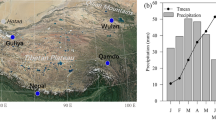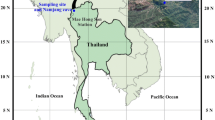Abstract
From the last deglaciation to the Holocene, the Greenland Ice Core (GISP2) δ 18O records as well as the records of ice-rafted debris on the surface of the North Atlantic have revealed a succession of sudden cooling events on the centennial to millennial scales. However, the temperature proxy records are rarely studied systematically and directly to ensure that this air temperature cooling pattern simultaneously existed in the East Asian Region, in addition to the repeated pattern occurring in the Greater Atlantic Region. A peat cellulose δ 18O temperature proxy record proximately existing for 14000 years was picked up from the Hani peat in Jilin Province, China. It suggests by comparison that the sudden cooling events, such as the Older Dryas, Inter-Allerød, Younger Dryas, and nine ice-rafted debris events of the North Atlantic, are almost entirely reiterated in the temperature signals of Hani peat cellulose δ 18O. These cooling events show that the repeatedly occurring temperature cooling pattern not only appeared in the North Atlantic Region in the high latitudes, but also in the Northwest Pacific Region in the middle latitudes. The climate change events marking the start of the Holocene Epoch, the Holocene Megathermal, the “8.2 kyr” event, the “4.2 kyr” event, the Medieval Warm Period, and the Little Ice Age are further discussed. The sensitivity response of Hani peat cellulose δ 18O to the land surface temperature and the reason for the age accuracy of peat cellulose 14C are also discussed based on the characteristics of the peat bog environment.
Similar content being viewed by others
References
Stuiver M, Grootes P M, Braziunas T F. The GISP2 δ 18O climate record of the past 16500 years and the role of the Sun, ocean, and volcanoes. Quat Res, 1995, 44: 341–354
Bond G, Showers W, Cheseby M, et al. A pervasive millennial-scale cycle in North Atlantic Holocene and glacial climates. Science, 1997, 278: 1257–1266
Bond G, Kromer B, Beer J, et al. Persistent solar influence on North Atlantic climate during the Holocene. Science, 2001, 294: 2130–2136
Hong Y T, Hong B, Lin Q H, et al. Correlation between Indian Ocean summer monsoon and North Atlantic climate during the Holocene. Earth Planet Sci Lett, 2003, 211: 371–380
Hong Y T, Hong B, Lin Q H, et al. Inverse phase oscillations between the East Asian and Indian Ocean summer monsoons during the last 12000 years and paleo-El Niño. Earth Planet Sci Lett, 2005, 231: 337–346
Yuan D X, Chen H, Edwards R L, et al. Timing, duration, and transitions of the last interglacial Asian monsoon. Science, 2004, 304: 575–578
Wang Y J, Chen H, Edwards R L, et al. The Holocene Asian monsoon: Links to solar changes and north Atlantic climate. Science, 2005, 308: 854–857
Qiao S Y. A preliminary study on Hani peat-mire in the west part of Changbai Mountain (in Chinese). Sci Geograph Sin, 1993, 13(3): 279–287
Green J W. Wood cellulose. In Whistler R L, ed. Methods in Carbohydrate Chemistry. New York: Academic Press, 1963. 9–22
Yapp C J, Epstein S. Climatic implications of D/H ratios of meteoric water over North America (9500.22000 B.P.) as inferred from ancient wood cellulose C-H hydrogen. Earth Planet Sci Lett, 1977, 34: 333–350
Barbour M M. Stable oxygen isotope composition of plant tissue: A review. Funct Plant Biol, 2007, 34: 83–94
Wershaw R L, Friedman I, Heller S J, et al. Hydrogen isotopic fractionation of water passing through trees. In: Hobson G D, Speers G C, Inderson D E, eds. Advances in Organic Geochemistry. International Series of Monographs on Earth Sciences. New York: Pergamon Press, 1966. 55–67
Dawson T E, Ehleringer J R. Streamside trees that do not use stream water. Nature, 1991, 350: 335–337
Libby L M, Pandolfi L J. Temperature dependence of isotope ratios in tree rings. Proc Natl Acad Sci U S A, 1974, 71: 2482–2486
Burk R L, Stuiver M. Oxygen isotope ratios in trees reflect mean annual temperature and humidity. Science, 1981, 211: 1417–1419
Ramesh R, Bhattacharya S K, Gopalan K. Climatic correlations in the stable isotope records of silver fir (Abies pindrow) trees from Kashmir, India. Earth Planet Sci Lett, 1986, 79: 66–74
Liu W G, Feng X H, Liu Y, et al. δ 18O values of tree rings as a proxy of monsoon precipitation in arid Nowthwest China. Chem Geol, 2004, 206: 73–80
Anderson W T, Bernasconi S M, Mckenzie J A, et al. Model evaluation for reconstructing the oxygen isotopic composition in precipitation from tree ring cellulose over the last century. Chem Geol, 2002, 182: 121–137
Bai G R, Wang S Z, Leng X T, et al. Bio-environmental mechanism of herbaceous peat forming (in Chinese). Acta Geograph Sin, 1999, 54(3): 247–254
Hong Y T, Jiang H B, Liu T S, et al. Response of climate to solar forcing in a 6000-year δ 18O time series of Chinese peat cellulose. Holocene, 2000, 10: 1–7
Yin S B, Liu X G. Discussion on “the theory on climate cause of peat forming” (in Chinese). Sci Geograph Sin, 2006, 26(3): 322-327
Dansgaard W. Stable isotopes in precipitation. Tellus, 1964, 16: 436–468
Gat J R. The isotopes of oxygen and hydrogen in precipitation. In: Fritz P, Fontes J C, eds. Handbook of Environmental Isotope Geochemistry. Amsterdam: Elsevier, 1980. 21–47
Rozanski K, Araguas-Araguas L, Gonfiantini R. Relation between long-term trends of oxygen-18 isotope composition of precipitation and climate. Science, 1992, 258: 981–985
Menot-Combes G, Burns S J, Leuenberger M. Variations of 18O/16O in plants from temperate peat bogs (Switzerland): Implications for paleoclimatic studies. Earth Planet Sci Lett, 2002, 202: 419–434
Stuiver M, Reimer P J, Bard E, et al. Radiocarbon calibration program rev 4.3. Radiocarbon, 1998, 40: 1041–1083
Genty D, Blamart D, Ghaleb B, et al. Timing and dynamics of the last deglaciation from European and North African δ 13C stalagmite profiles. Comparison with Chinese and South Hemisphere stalagmites. Quat Sci Rev, 2006, 25: 2118–2142
Shi Y F, Kong Z C, Wang S M, et al. The climatic fluctuation and important events of holocene megathermal in China. Sci China Ser B, 1992, 12: 1300–1308
Wang S W, Gong D Y. Climate in China during the four special periods in Holocene (in Chinese). Prog Nat Sci, 2000, 10(4): 325–332
Sun X J, Yuan S M. Vegetation evolution from pollen records in Jinchuan, Jilin Province in the past 10000 years. In: Liu T S, eds. Loess · Quaternary Geology · Global Change. Beijing: Science Press, 1990. 46–57
Broecker W. Does the trigger for abrupt climate change reside in the ocean or in the atmosphere? Science, 2003, 300: 1519–1522
Alley R B, Agustsdottir A M. The 8k event: Cause and consequences of a major Holocene abrupt climate change. Quat Sci Rev, 2005, 24: 1123–1149
Rohling E J, Palike H. Centennial-scale climate cooling with a sudden cold event around 8200 years ago. Nature, 2005, 434: 975–979
Reimer J, Baillie M G L, Bard E, et al. Residual delta 14C around 2000 year moving average of IntCal04. Radiocarbon, 2004, 46: 1029–1058
Xia Z K, Yang X Y. Preliminary study on the flood events about 4 ka B.P. in north China (in Chinese). Quat Sci, 2003, 23: 667–674
Wu W X, Liu T S. Variations in east Asia monsoon around 4000 a B.P. and the collapse of Neolithic cultures around central plain (in Chinese). Quat Sci, 2004, 24: 278–284
Staubwasser W, Sirocko F, Grootes P M, et al. Climate change at 4.2 ka BP termination of the Indus valley civilization and Holocene south Asian monsoon variability. Geophys Res Lett, 2003, 30: 1425–1428
Hong B, Lin Q H, Hong Y T, et al. Interconnections between the Asian monsoon, ENSO, and high northern latitude climate during the Holocene. Chin Sci Bull, 2006, 51(18): 2169–2177
Weiss H, Courty M A, Wetterstrom W, et al. The genesis and collapse of third millennial north Mesopotamian civilization. Science, 1993, 261: 995–1004
Kutzbach J E. The changing pulse of the monsoon. In: Fein J S, Stephens P L, eds. Monsoons. New York: John Wiley & Sons, 1987. 247–269
de Menocal P B. Cultural responses to climate change during the late Holocene. Science, 2001, 292: 670–673
Yu W C. The secret for the decline of Liangzhu Culture and Longshan Culture (in Chinese). Cultur Rel, 1992, 3: 27–28
Zhang D E. Evidence for the existence of the Medieval Warm Period in China. Clim Change, 1994, 26(3): 293–297
Ge Q S, Zheng J Y, Liu J. Amplitude and rhythm of winter half-year temperature change in eastern China for the past 2000 years (in Chinese). Adv Clim Change Res, 2006, 2(3): 108–112
Yang B, Kang X C, Shi Y F. Decadal climatic variations indicated by Dulan tree-ring and the comparison with the temperature proxy data from other regions of China during the last 2000 years. Sci Geograph Sin, 2000, 20(5): 397–402
Liu J, Hans von Storch, Chen X, et al. Simulated and reconstructed winter temperature in the eastern China during the last millennium. Chin Sci Bull, 2005, 50(24): 2872–2877
Hodell D A, Curtis J H, Brenner M. Possible role of climate in the collapse of Classic Maya civilization. Nature, 1995, 375: 391–394
Zhu K Z. A preliminary dtudy on the climatic fluctuations during the last 5000 years in China. Sci China Ser A, 1973, 16(2): 226–256
Bas Van Geel, Johannes Van Der Plicht, Kilian M R, et al. The Sharp rise of δ 14C ca. 800 cal BC: Possible cause, related climatic teleconnections and the impact on human environments. Radiocarbon, 1998, 40(1): 535–550
Author information
Authors and Affiliations
Corresponding author
Additional information
Supported by National Natural Science Foundation of China (Grant Nos. 40573004, 40673069, 40231007)
Rights and permissions
About this article
Cite this article
Hong, B., Liu, C., Lin, Q. et al. Temperature evolution from the δ 18O record of Hani peat, Northeast China, in the last 14000 years. Sci. China Ser. D-Earth Sci. 52, 952–964 (2009). https://doi.org/10.1007/s11430-009-0086-z
Received:
Accepted:
Published:
Issue Date:
DOI: https://doi.org/10.1007/s11430-009-0086-z




